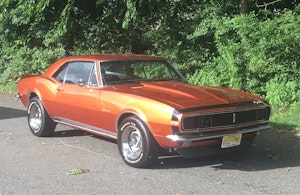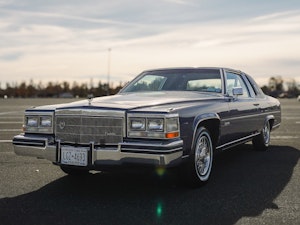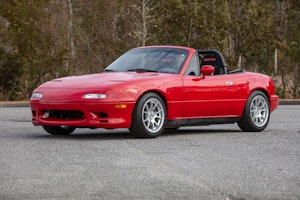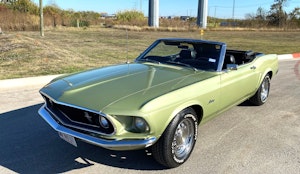As cheap Mustangs go, these are the 5 to corral
People like to poop on Mustangs for all sorts of reasons, but one popular refrain is that they’re a dime a dozen. Sure, fine, they’re not rare cars, and by August 2018 Ford had built 10 million of the things. But there’s something to be said for democratizing performance, and anyone who has ever mashed the throttle of a V-8 Mustang has done so gladly and with a smile on their face.
Over the years there have been plenty of rare variants, and those tend to bring big bucks and occasionally make headlines when they come up for sale. No Mustang has brought bigger bucks than the 1968 Highland Green 390 fastback from the movie Bullitt, which sold for $3.74 million in January 2020. But it’s the run-of-the-mill Mustangs that make for easy access and touch the lives of the most people. And while Mustang ownership is technically easiest with a slushbox-shifting base-model with as few cylinders as possible, enthusiasts are after a bit of V-8 kick and they’re willing to fork over a few extra dollars to get it.
Still keeping both V-8 and value in mind, here are the cheapest eight-cylinder Mustangs by generation (we price the first through fifth gens) and #2 condition (Excellent), value in the Hagerty Price Guide.
First gen (1965–73): 1970 Mustang Coupe, $18,100

With a few minor updates (notably a return to single headlights), the 1970 Mustang was largely a carryover from ’69, and Ford built nearly 191,000 of them for the model year. Nine different engines were offered, including a pair of sixes, 428- and 429-cubic-inch big-blocks, and the new 351 Cleveland V-8, a $48 option. The base V-8 coupe, however, with its two-barrel 302 making 220 horsepower, slots in as the most affordable V-8 of the bunch today. Cars equipped with an automatic offer a slight discount, but then where’s the fun in that?
Second gen (1974–78): 1975 Mustang II Coupe, $14,100

Many enthusiasts view the Mustang II as a dim, dim light in the Dark Ages of American performance cars. One of the more generous views is that it was “the right car at the right time.” It was a car, alright, but in those post-performance years, this pioneering pony car served a different master: economy.
As such, the II was smaller than its predecessor in every way. Little changed inside or outside the car during its production run but, mercifully, a 5.0-liter V-8 joined the 2.8-liter V-6 and 2.3-liter four on the spec sheet for 1975. With 8.0:1 compression and 122 horsepower, it was nothing to write home about even in the mid-1970s, and we’re pretty certain no one ever did. For a very long time, these were $5500 cars, but since late 2020, values have skyrocketed, relatively speaking. Still, the V-8 Mustang II coupe slots in as the most affordable of the era.
Third gen (1979–93): 1987 Mustang 5.0 LX Coupe, $16,600

What a trooper the Fox-body Mustang was. Few cars soldier on for so long yet still sell like gangbusters. In fact, by the time production ended after that 15-year run, about 2.7 million of them had hit the road—that’s a Fox-body Mustang for every citizen of Botswana.
As for the ’87 model, there were big changes. For starters, the Mercury Capri went away, as did the turbocharged SVO Mustang, as did the V-6 option, which left only LX and GT Mustangs with four (yuck!) or eight (yay!) cylinders. Front and rear fascias were updated, aero-look headlights showed the way, and lower bodyside moldings framed the Mustang in a more Euro fashion. An LX will always lack the cachet of a GT, so it’s no surprise they are the cheaper option among enthusiasts today. But—spoiler alert!—you still get a five-speed manual and that great 5.0 with its 225 hp and 300 lb-ft of torque, so we’d hardly call this a loss.
Fourth gen (1994–2004): 1996 Mustang GT, $11,800

The venerable 5.0 V-8 soldiered on in the first couple years of production of the Mustang’s SN95 generation, but it was replaced with Ford’s new overhead cam 4.6-liter Modular unit for 1996. Despite being smaller, the more refined engine made the same power while delivering better fuel economy and reduced emissions. The change made plenty of people grumpy, which may account for the ’96 slotting in as not only the cheapest Mustang of the generation, but the cheapest V-8 Mustang overall.
For how long is anyone’s guess; values have been flat for a decade but that could mean an opportunity for collectors in the near future. In a model year that offered the potent Cobra and the crazy Mystic paint job, this regular old GT may seem pretty plain, but it’ll still put a smile on your face.
Fifth Gen (2005–14): 2005 Mustang GT, $22,700
The Mustang got a ground-up redo for 2005, with a new chassis, throwback styling, and an all-aluminum 4.6-liter V-8 featuring variable camshaft timing and making a quite respectable 300 hp and 320 lb-ft—enough to propel the car to 60 mph in 5.1 seconds. To the surprise of many, Ford kept the Mustang’s solid rear axle but vastly upgraded the ancient four-link way it had been tended to, with improved shocks, softer springs, and control arms that benefited from the addition of a Panhard rod. In short, the new Mustang was fast and it handled itself well. If those things are important to you, it’s probably well worth your time to seek one out, especially because values have been on the rise for the last 24 months.
***
Marketplace
Buy and sell classics with confidence
Check out the Hagerty Media homepage so you don’t miss a single story, or better yet, bookmark it. To get our best stories delivered right to your inbox, subscribe to our newsletters.

















I’m of the opinion that the 1971 – 1973 models are so different in style from their predecessors, that THEY are the true second-generation models. No interchangeability of body parts with older models was possible.
At the time, most people agreed, and many referred to them as such.
Agreed, I still can’t believe they aren’t considered second generations in modern times. They are just as unique as the fourth generation SN-95 vs. the previous Fox.
71-73 is a second gen. The Mustang II is not really a Mustang it was a Pinto. At least in my opinion.
I disagree. It bridged the gap during the oil embargo years and kept the Mustang line intact. I owed a 78 Mustang II for ten years and drove it everywhere. I’ve also owned a 2002 Mustang, which was a great ride, and still own my 1967 Mustang convertible. Does my 78 compare to my other ones? No, but it was very reliable, and I appreciate it’s place in Mustang history.
The 1st gen was a Falcon. What of it?
I had a ’64 Falcon Sprint coupe and it was identical inside to the “64 1/2” Mustang. Same dash. The Sprint package included a 260 V8 and mine had a 4 speed top loader. The fact that the Mustang was built on the Falcon platform is what allowed Lee Iacoca to convince Henry Ford II to produce the Mustang. I was a supervisor/manager at a Ford owned subsidiary and drove everything from the Mustang II (mine had the V6 because I wanted the 4 speed) to the first of the Fox Bodys as my executive lease cars. I still own a Falcon based first gen Mustang. A ’69 convertible with a “built” 302. Still having fun with that car after 25 years and a cross country trip in it.
Not that I would knock the first generation in anyway but your suggestion that the Mustang II was just a Pinto is an out of date comment typical of the 70s and 80s. Yes the II was based on the Pinto platform but the first gen was originally based on the Falcon and later the Fairlane in the same way. Both mostly utilitarian cars for the masses unless upgraded. I owned a Mustang II in the 80s and while many passed it off as just a Pinto (had on of those as well), smarter folks were modifying their IIs to get some horsepower out of that 302. Same as even others were transplanting 289s and 302s into their Pintos. I have driven both first gens and the Mustang II and while the ’65 and ’66 I drove (a friend’s cars) commanded attention like no car I’ve ever tried, my little Mustang II was a Ghia based model and out handled the 60s versions by a long shot. Two different kinds of fun both provided by old Fords.
My second executive lease car was a ’78 Mustang II fastback. The car was all black, had T-tops with a Crown Victoria looking bar over the roof, little 13″ slot mags with RWL tires and a screaming red interior. It got tons of comments at the grocery store parking lot or the gas station. That’s why Ford provided that executive perk. I ordered mine with the 2.6L V6 because I was in CA and they didn’t permit the V8 version with a 4 speed. I liked to shift. The V6 was plenty of power, with a crisp throttle response, was close to the 302 (5.0L) in hp rating and was fun to drive.
Wife loved that little car! 3 children drove it many miles!
Had no mechanical probs at all. Rust became the downfall of this little beauty!
71-73 Mustangs share the same platforn/chassie as 65-69. 71-73 is a little longer and wider, but still share many parts from the earlier models. That’s why they are considerd 1st gen models.
I’ve been restoring first gen Mustangs since my son bought a ’69 Mach 1 in 1994. I always wondered how they classified the ’71-’73 cars as first gen. I admit they shared a lot of peripheral parts with the ’65-’70 cars but they were a completely different platform. My current ’69 convertible has ’72 front disc brakes on it because I wanted the heavier spindles but, otherwise, most of the ’71-’73 stuff is incompatible (except drive trains).
BTW, my son is now 47 and still has his Mach 1 in his garage. Restoring that car with him when he was 17 was one of the most gratifying experiences of being his dad. He’s got two little boys now and he’s freshening up the Mach 1 for the 10 year old and bought a ’64 Falcon Futura convertible with a 302 for the 7 year old. Being a hobby wrencher lives on.
They are the same design but with some upgrades & improvements.
I disagree. I remember those cars when they were new and I don’t remember anyone saying that they weren’t real Mustangs. Some people said they were getting too big but that was a trend that began with the first design iteration in 1967. Body panels don’t typically interchange from one iteration to the next: not 1966-’67 or 1968 – 1969, etc.
As for the Mustang II that was a totally different car than any 1965-1973 Mustang; it should never be mentioned in the context of Mustangs! As for the fox body cars that followed they were not Mustangs either. They shared no styling cues with the 1965-1973 cars and were among the most anonymous cars Ford ever built. To call the cars from 1974 to 1992 ‘Mustang’ or even ‘Mustang II’ was just false advertising. I drove a 1974 M II from 1976 to 1982 and it was the least reliable, most trouble prone car I ever had.
The ’71-’73 Stangs were aircraft carriers. The fastback wasn’t even that attractive. First gen had three body changes all built on the same platform with the same wheel base. The ’65-’66 cars (there weren’t any “’64 1/2” Mustangs, just early ’65s). The ’67-’68 cars lost the slab sided look and got more muscular looking stampings on the identical platform. Finally the ’69-’70 cars got even more muscular looking sheet metal, but still shared the same platform with the ’65s. The ’71-’73 cars were a completely different platform and wheel base. They did share some peripheral parts with the earlier cars but they were far from interchangeable.
Ford had 63 1/2 Fairlane that’s when they went to the fastback and they had 64 1/2 Mustang that initially came out with 3 speed on floor with 6 cylinder. I used to wash cars and saw the first one and washed it. Thought it was a p o s. But once the 289 came out it outpaced my 65 327 Chevrolet SS
‘Mustang’ Mach E EV thingy should never be mentioned, either
What you called the first generation looked nothing like the original Mustang.
All that changed on the 71 – 73 was the sheet metal . . . same suspension, same brakes, same axles, same drivetrains. The car grew a bunch but no where near the change for 2005 . . . which was an entirely new car based on a Lincoln LS platform.
A friend back in the early 80s, had the #16 Folmer TransAm car . . . when he sold it the new owner discovered that the entire suspension had been transferred to a 71. He had to go find that car & buy it to do the restoration, which was done by 84 & it showed up at SAAC 9 in Anaheim.
I have to laugh at that $16,600 for an LX coupe. Try like 25-35k for a nice one. Not that I think they’re worth it. Mustang coupes of that generation remind me of Chrysler K-cars. If you want to find a good deal on a fox, your best bet is a carbureted four eyed GT. Those can still be had in nice shape for under 20 grand. Especially the 83-84s.
It was light and as a coupe more rigid than the hatch. As for looks, who cares? It’s infinitely tunable and parts are plentiful.
Agreed. An unmodified 5.0 Notch is very hard to find – unless it is an automatic.
For good reason too, extremely easy to turn one into a solid mid 13 second performer with zero impact to drivability or reliability.
Those cars were one of the best bang for the buck performance bargains.
Yes they were! I had a 1991 all oem 302, 5 speed, oem 308 gears and the clutch style “kinda ok” posi. Super fun, the springs were pretty stiff but it drove ok, and 22 mpg. I was 3rd owner and it was super well cared for before me and while I owned it. Sold it for $3000 in 2006 with 176,000 well maintained miles.
The notch was roughly 60 lbs lighter than the hatch. Not enough difference to make up for the homely looks. I’d rather go a tenth slower in the quarter mile. And who cares about looks? I’d say most people do. There’s a reason the hatch outsold it handily. The only ones that look decent to me are the SSP cars.
It was also stiffer because of the small cargo hole, which made it better for road racing too. There’s a reason why notches have a niche following.
I realize a car with a trunk offers some stiffness versus a hatch, but I just don’t feel the fox design lent itself well to a 3 box layout. It was meant to be a hatch/fastback. Other generations can pull it off better, but not that one. Niche also doesn’t warrant the premium asking price. A good set of subframe connectors fix the hatchback stiffness…ask me how I know.
Subframe connectors (and K-member braces!) make Fox convertibles a lot stiffer too, ask me how I know. 🙂 You are absolutely right but the notch’s advantages out of the box (stiff, light) earned them a loyal following in the 1990s and nothing is likely to ever change that.
The 3rd gen is the one to consider if you can find a clean one not beat to death.
I can’t get into the Mustang II no matter what.
… size issues?
Friends don’t let Santa drive Mustangs!
Always, always thought they were over-rated, esp Gen 1! Camaro also, however.
Just sayin’ !
I’ve always disagreed with the ‘date range’ of the ‘First Gen’ Mustangs, especially when there are MAJOR differences in the the 1971-1973 Mustangs. Granted, it was only 3 years or so, however if one puts a ’65 -’69 next to a ’71-’73, the changes were major, and not all ‘for the good’.
And, this is coming from someone who owned a ’71..
Have you checked foxbody prices lately? I think you’re low. Especially on an 87-93 notchback which is the one everyone wants!
The Fox Mustangs are hotter than ever since that crowd is coming of age to buy the cars they either had years ago or to buy the car they couldn’t get back then.
The cheapest 5.0s are the convertible automatics. In fact, the coupes are the most desirable of all.
They aren’t bad cars but they weren’t Mustangs by any means.
Yes they were, it says so right on the car. It was also better in every way than the original mustang, better steering, better braking, and more reliable.
Maybe you could say the original had more style but that doesn’t make it drive better.
Actually, they WERE Mustangs – agile two-doors, with various performance versions available, yet affordable to those with lower-middle-class incomes and above.
Too bad so many folks adopt such a parochial attitude towards Mustangs (and other cars).
GT, convertible, automatic. Heavy, slow, and underwhelming.
Perfect investment for cruises and parking lot shows.
If one wants to actually enjoy the car, get a 5.0, notch, stick. Then do the “mods”. If you don’t know them, just get an automatic car.
Had a purple 97 Saleen convertible which was stolen (frown). Also have a 2007 Shelby with the 4.6. Absolute pleasure to drive and corners like a dream. The borla exhaust has a sweet tone but not so loud that you can’t listen to tunes. Bought it years ago under $25,000. Guaranteed smile every time you press the right pedal.
I purchased a 1994 GT convertible about 5 years ago with 65,000 miles on it. It still runs like a clock and is fun to drive. Values have not gone up much, but perhaps some day.
I’d love to get a nice foxbody, 87-93 range. Calypso green/ teal. A decent one seems to be $10,000+ currently. A Saleen would be the bomb, Cobra, or a coupe (notch) with a 5 speed too.
Mine is a 2006 GT 5-speed convertible. I bought it in spring of 2021, almost 3 years ago for $9000 (60,000 miles). It has definitely increased in value, but it has not taken on the muscle car demand that I thought it might by now. It’s definitely a throw-back style-wise, and I love the V8 5-speed combo, which takes me back to my first car – 67 RS Camaro convertible 327 4-speed. It’s a keeper until I find my dream car C2 Corvette.
Your time may soon be arriving with the SCCA creating a spec class for cars like yours next year.
Why only V8’s? The 4.0L and 3.7L V6 S197’s are super affordable right now, and their performance will leave most of the cars on this list in the dust.
Have you ever driven a 5.0 notchback? 4th or 5th gen GT?
By “most” you mean the Mustang (also) and the 1st gen low perf engines, maybe. But it is still a V6 and nothing says College Girl like a V6, Automatic Mustang.
It’s similar to folks that ask why 3rd gen Camaro RS aren’t really worth much. Because the 170hp TBI 305 is a laughable joke .
210 HP from the 4.0L (same as the previous generation’s V8), and 305 HP from the 3.7L (again, same as the previous generation’s V8). The 3.7L is in the top 10 for 0-60 times of all Mustangs ever produced, and both will outhandle most of the Mustangs ever built. Yes, the Coyote will win in a drag race, but I’ve sent several back to the pits with their tail between their legs on the road course with my V6, due to it’s lighter weight and better handling.
Fortunately I survived the epoch times I had in my 69 mach 1 428 in the early 70’s. Street racing, cruising and boozing. I often wonder how I never wrecked out. Best of memories. So for me, obviously, that era was the best of the Mustangs.
I had the same 69 Mach 1 back in the mid-70’s and I’ve often wondered the same thing – many good times in that car! Later had a 74 Mustang II. Now have a 07 GT/CS, V8 & 5-speed.
First of all, Ford owns the rights to the Mustang name and trademarks, so the Blue Oval has the last word in what is or is not a Mustang to all you Mach E and Mustang II haters out there.
Secondly, like it or not, Mustang II is credited with saving the Mustang. By 1969, the Mustang had gotten so large and drifted so far from what it started out with even Carroll Shelby asked to exit his partnership with Ford.
Between upcoming safety and emissions regulations, Ford was between a rock and a regulatory hard place. The 1973 oil embargo didn’t help. The initial 74 model Mustang II didn’t even offer a V8, further souring enthusiasts perception of the Mustang II as an overgrown Pinto.
We wouldn’t have a Fox body or any of the subsequent generations without the Mustang II. You don’t have to love or even like the MII but at least respect its place in Mustang history
Having had dozens of Mustangs (but never a Mustang II) I can say with confidence that the Fox bodies are the sweet spot and prices have dropped some post COVID. My 66 GT coupe 3sp manual was like driving a dump truck and while it was a pretty car in Highlands green, it was barely above a Flintstones car. The Fox bodies were a quantum leap. But the real Mustang deal is a 2018+ ecoboost. They can be had for $20K with low miles and are an incredible value with 315 HP and easy to upgrade and mod. Not a V8 but a heck of a deal. The car I really want now? A 2013 Boss 302 in yellow.
65-66 Mustang GTs were automatic or 4-speed. If your Mustang had a 3-speed that could explain why it drove like a truck. The early Mustangs cannot compete in quality with the later machines, but they don’t have to.
Agreed, the ecoboost 2.3’s are great cars, and I hope the V8 chest thumpers continue to look down their noses at them, and their value continues to drop, so I can buy one and mod it guilt free.
I’ve owned mustangs all my life High school I had a 69 with a 302.
That car was such a babe magnet.
Then a 73 grande, 351-C, it was fast, but seemed too big and bulky.
I got a great deal on a 74 Mach 1, (i was soooo angry at what ford did to this legend) It had low mileage, fastback, (yeah right) Bright red, black lower panels, and those famous factory “Mach one” decals slapped on the sides, the black interior with red lights on the inner doors made this car look soooo cool. It’s looks were very appealing
However the lacking V6, -this was no Mach one. That X on the Vin number only made her difficult to insure cheaply.
Next stop a 1980 mustang 3 door, 2.3 engine, 4 speed, (I was going for mileage) after I busted out the insides of that red glowing cat converter folly under the hood, and put a Holly carburetor, it ran good -and it still passed emissions.
I put 240k miles, several clutches and a valve job before we parted.
My last want was a convertible.
2000 with laser red paint 50k miles.
V6 5 speed. -didnt see the need for a V8 when your only protection is a cloth roof.
Added duel exhaust (Ford really cheapened out on the stock exhaust)
Cold air intake made her come to life.
Garaged most of the time, but nothing more exilerating than a midnight drive in the warm desert
with the top down…